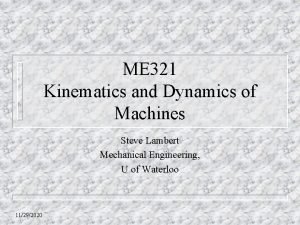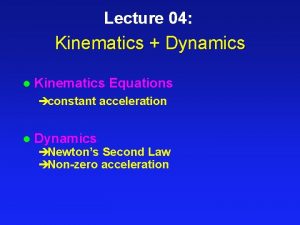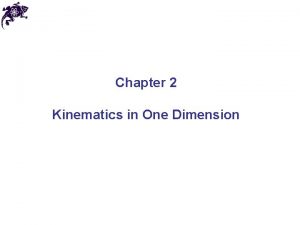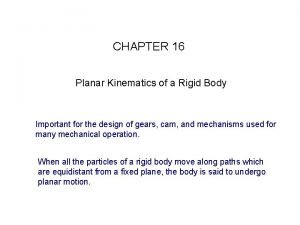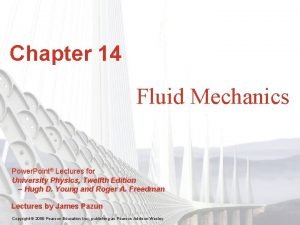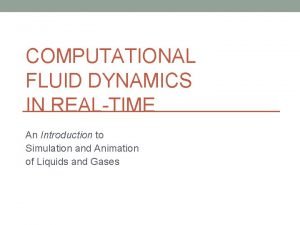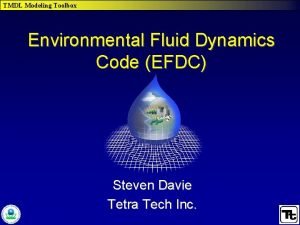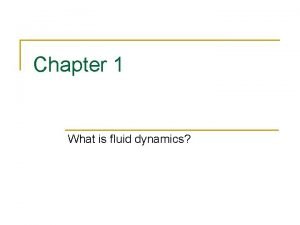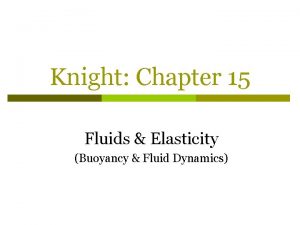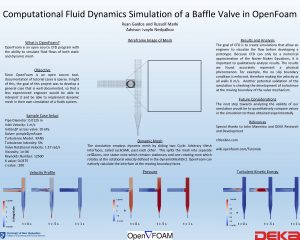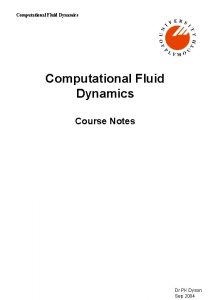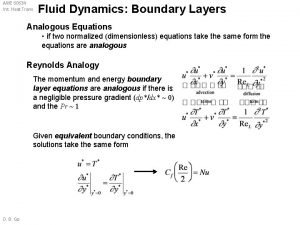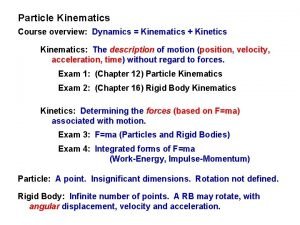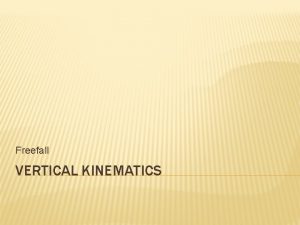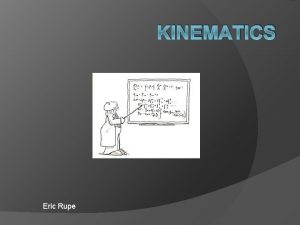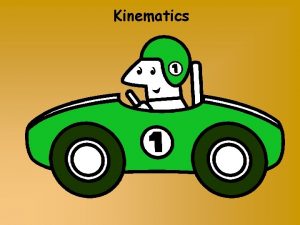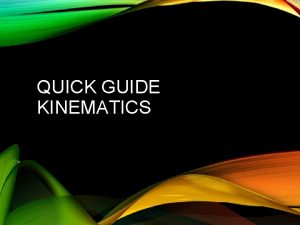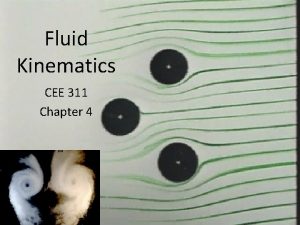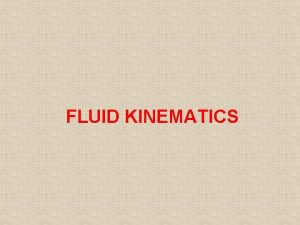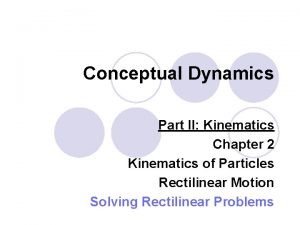Fluid Kinematics Fluid Dynamics Fluid Flow Concepts and














- Slides: 14

Fluid Kinematics Fluid Dynamics

Fluid Flow Concepts and Reynolds Transport Theorem ä Descriptions of: ä fluid motion ä fluid flows ä temporal and spatial classifications ä Analysis Approaches ä Lagrangian ä Moving vs. Eulerian from a system to a control volume ä Reynolds Transport Theorem

Descriptions of Fluid Motion ä streamline Defined instantaneously has the direction of the velocity vector at each point ä no flow across the streamline ä steady flow streamlines are fixed in space ä unsteady flow streamlines move ä ä pathline Defined as particle moves (over time) path of a particle ä same as streamline for steady flow ä ä streakline tracer injected continuously into a flow ä same as pathline and streamline for steady flow ä

Streamlines V 2, b 2 V 1, b 1 Tom Hsu’s numerical simulation Ideal flow machine

Descriptors of Fluid Flows ä Laminar flow ä fluid moves along smooth paths ä viscosity damps any tendency to swirl or mix ä Turbulent ä fluid flow moves in very irregular paths ä efficient mixing ä velocity at a point fluctuates

Temporal/Spatial Classifications ä Steady - unsteady ä Changing ä Uniform in time - nonuniform ä Changing in space Can turbulent flow be steady? _______ If ________ averaged over a ________ suitable time

Analysis Approaches ä Lagrangian (system approach) ä Describes a defined _____ mass (position, velocity, acceleration, pressure, temperature, etc. ) as functions of time ä Track the location of a migrating bird ä Eulerian field (velocity, acceleration, the flow ______ pressure, temperature, etc. ) as functions of position and time ä Count the birds passing a particular location ä Describes If you were going to study water flowing in a pipeline, which approach would you use? ______ Eulerian

The Dilemma ä The laws of physics in their simplest forms describe systems (the Lagrangian approach) ä Conservation ä It of Mass, Momentum, Energy is impossible to keep track of the system in many fluids problems ä The laws of physics must still hold in a Eulerian world! ä We need some tools to bridge the gap

Reynolds Transport Theorem äA moving system flows through the fixed control volume. ä The moving system transports extensive properties across the control volume surfaces. ä We need a bookkeeping method to keep track of the properties that are being transported into and out of the control volume

Control Volume Conservation Equation B =_____________ Total amount of some property in the system b = Amount of the property ______ per unit mass Rate of increase of the property in the system = Rate of increase of the property in the control volume + Rate of efflux of the property across the control volume boundary

Control Volume Conservation Equation 0 = -1 + (-0 + 1) 0 = 1 + (-1 + 0) 0 = 0 + (-0 + 0)

Application of Reynolds Transport Theorem ä Conservation of mass (for all species) ä Newton’s 2 nd law of motion (momentum) F = ma _______ ä First law of thermodynamics (energy)

Summary ä Reynolds Transport Theorem can be applied to a control volume of finite size ä We don’t need to know the flow details within the control volume! ä We do need to know what is happening at the control surfaces. ä We will use Reynolds Transport Theorem to solve many practical fluids problems

Mt. St. Helens
 Fluid kinematics
Fluid kinematics Aplusphysics kinematics-horizontal kinematics
Aplusphysics kinematics-horizontal kinematics Kinematics and dynamics of machines
Kinematics and dynamics of machines Kinematics acceleration formula
Kinematics acceleration formula A tourist being chased by an angry bear
A tourist being chased by an angry bear Planar kinematics of a rigid body
Planar kinematics of a rigid body Fluid kinematics - ppt
Fluid kinematics - ppt Real time fluid dynamics for games
Real time fluid dynamics for games Environmental fluid dynamics code
Environmental fluid dynamics code Fluid dynamics definition
Fluid dynamics definition Fluid dynamics
Fluid dynamics Fluid mechanics is the study of
Fluid mechanics is the study of Fluid dynamics
Fluid dynamics Fluid dynamics
Fluid dynamics Fluid dynamics
Fluid dynamics


